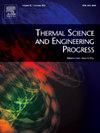两种抛物面槽太阳能集热器用于温室采暖的热性能对比分析:实验研究
IF 5.1
3区 工程技术
Q2 ENERGY & FUELS
引用次数: 0
摘要
为了提高太阳能的利用率,解决双接收管抛物面槽太阳能空气集热器(PTSAC-DRTs)用于太阳能温室采暖的出口温度高、进出口温差大的问题,设计了一种新型的三接收管抛物面槽太阳能空气集热器(PTSAC-TRTs)。该设计是基于增加集热器内的空气质量流量,以防止集热器出口温度过高。设计并进行了实验,研究了风速、太阳辐照度、集热器入口处空气温度和外保温板对ptsac - trt集热性能的影响。从集热器出口空气温度、集热器效率和归一化温差效率曲线等方面比较了ptsac - drt和ptsac - trt的性能。ptsac - trt的最佳风速为5.4 m/s,其瞬时收集效率(ICE)高达76.0%。集热器在实际应用中不需要任何额外的绝缘,因此既有效又实用。在最佳风速条件下,PTSAC-TRTs出口温度始终比PTSAC-DRTs出口温度低1 ~ 4℃。与PTSAC-TRTs相比,PTSAC-TRTs的单位面积平均采热量和平均ICE分别高出10.7%和10.4%。ptsac - trt被用作热收集装置,有效地为太阳能温室提供能量,确保了比参考温室更高的室内温度(平均高3.6°C)。本文章由计算机程序翻译,如有差异,请以英文原文为准。
Comparative analysis of the thermal performances of two parabolic trough solar air collectors used for greenhouse heating: An experimental study
In order to improve the solar energy utilization rate and address the issues of high outlet temperature and large temperature difference between the inlet and outlet of a parabolic trough solar air collector with double-receiver tubes (PTSAC-DRTs) used for solar greenhouse heating, a novel parabolic trough solar air collector with triple-receiver tubes (PTSAC-TRTs) was designed in this study. The design was based on increasing the air mass flow rate in the collector to prevent excessively high temperatures at the collector outlet. Experiments were designed and carried out to investigate the influence of four parameters, including the air velocity, solar irradiance, air temperature at the collector inlet, and presence of an external insulation board, on the heat collection performance of the PTSAC-TRTs. The performances of the PTSAC-DRTs and PTSAC-TRTs were compared in terms of the air temperature at the collector outlet, collector efficiency, and normalized temperature difference–efficiency curve. The optimum air velocity was 5.4 m/s for the PTSAC-TRTs, which had an instantaneous collection efficiency (ICE) of up to 76.0 %. The collector did not require any additional insulation for practical application and is thus both efficient and practical. Using the optimum air velocity, the air temperature at the PTSAC-TRTs outlet was consistently 1–4 °C lower than that at the PTSAC-DRTs outlet. Compared with the PTSAC-DRTs, the average heat collection per unit area and average ICE of the PTSAC-TRTs were 10.7 % and 10.4 % higher, respectively. The PTSAC-TRTs was used as a thermal collection device to efficiently supply energy to a solar greenhouse, ensuring a higher indoor temperature (3.6 °C higher on average) than that of a reference greenhouse.
求助全文
通过发布文献求助,成功后即可免费获取论文全文。
去求助
来源期刊

Thermal Science and Engineering Progress
Chemical Engineering-Fluid Flow and Transfer Processes
CiteScore
7.20
自引率
10.40%
发文量
327
审稿时长
41 days
期刊介绍:
Thermal Science and Engineering Progress (TSEP) publishes original, high-quality research articles that span activities ranging from fundamental scientific research and discussion of the more controversial thermodynamic theories, to developments in thermal engineering that are in many instances examples of the way scientists and engineers are addressing the challenges facing a growing population – smart cities and global warming – maximising thermodynamic efficiencies and minimising all heat losses. It is intended that these will be of current relevance and interest to industry, academia and other practitioners. It is evident that many specialised journals in thermal and, to some extent, in fluid disciplines tend to focus on topics that can be classified as fundamental in nature, or are ‘applied’ and near-market. Thermal Science and Engineering Progress will bridge the gap between these two areas, allowing authors to make an easy choice, should they or a journal editor feel that their papers are ‘out of scope’ when considering other journals. The range of topics covered by Thermal Science and Engineering Progress addresses the rapid rate of development being made in thermal transfer processes as they affect traditional fields, and important growth in the topical research areas of aerospace, thermal biological and medical systems, electronics and nano-technologies, renewable energy systems, food production (including agriculture), and the need to minimise man-made thermal impacts on climate change. Review articles on appropriate topics for TSEP are encouraged, although until TSEP is fully established, these will be limited in number. Before submitting such articles, please contact one of the Editors, or a member of the Editorial Advisory Board with an outline of your proposal and your expertise in the area of your review.
 求助内容:
求助内容: 应助结果提醒方式:
应助结果提醒方式:


